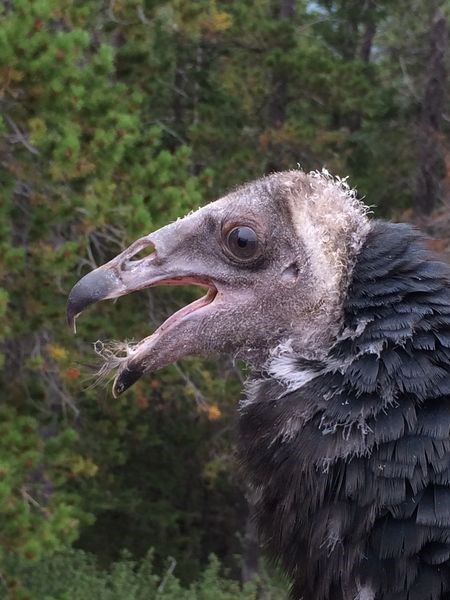Since 2003, research has been going on in Saskatchewan, at the extreme northern edge of the turkey vulture range. Tanya Lawson, assistant to the project in 2015 gave a detailed presentation of the finding of the research. Kelsey Ecological Society hosted the presentation in Preeceville on March 12.
The project is the largest nesting Turkey Vulture wing-tagging program in North America with 14 large wing tags, with a white letter and two numbers on a green herculite tag, which were applied at nine nests in 2003, 30 at 17 nests in 2004, 43 at 29 nests in 2005, 84 at 46 nests in 2006, 78 at 43 nests in 2007, 98 at 56 nests in 2008, 2012,158 in 87 nests in 2013, 134 in 74 nests in 2014, 126 in 73 nests in 2015. There was a total of 1,352 nestlings that were tagged in 767 successful attempts in 240 buildings (13 new first-usage in 2015) in 13 years. Most adult vultures winter in Venezuela.
Not one tagged bird has yet been found unfledged in a building where tagged, except: one impaled in barbed wire, one in a knothole, one in the lower level of a building with no escape window, and one when its parents died. The research has now recorded over 400 sightings ofvulture tags, including about 30 sightings four to nine years after tagging (presumed longevity of a large species).
Home ranges varied from 49 to 1,992 square kilometres. The male and female took turns incubating, but one female did all the brooding for five days. Each adult traveled up to 80 km to obtain food for its young and spent up to 13 hours on a single carcass, then returned to its nest with dead meat. Young probe deep into adult’s gullet to retrieve it. Each adult visits young briefly once a day on average and may roost all night from one to 39 km distant from the nest house.
The only nestlings to ever carry a satellite transmitter (two wereapplied west of Leoville on August 5, 2004 and August 6, 2007). The 2004 vulture wintered in Costa Rica and then died in Nebraska in July 2005. The 2007 nestling passed through Vera Cruz, and into Oaxaca, Mexico, where its transmitter ceased sending signals on 1 December. It averaged only 73 km/day, flying only three hours in each average day. Z58 and Z59 (the second two nestlings) were tagged west of MacDowall in August 2013. Both wintered in Costa Rica where Z58 died 28 February 2014 and Z59 wintered twice. Thus three of three transmitted nestling vultures “short-stopped” for winter in Costa Rica. The only seven adult vultures captured on their nest, are carrying GPS transmitters that provide hourly reports of location within 10 m accuracy. Two transmitters were applied each year in 2005, one in 2007, two each in 2009 and 2013, providing hourly reports that tell of slow flight in warm thermals in mid-day.
The first five adult turkey vultures tracked to southern Venezuela demonstrated the size of their winter territory. Five nestlings, tagged at Canwood, Debden, Nora, Victor, and Yellow Creek, had their wing tags read in Maracaibo, Venezuela in winter. An adult given a transmitter near Leoville in 2007 went over 6,000 km to reach Venezuela in 59 days but took only 45 days on the return trip north. The adult from west of MacDowall in 2007 took an astounding 114 days to get to its wintering area in Venezuela and made the return trip north in 64 days. One 2013 adult went the farthest east in Venezuela, the other went the farthest south, southeast of Bogota, Colombia
Until 1982, vultures nested in caves along river banks, or in dense brush piles. Then a few learned to nest in attics or basements of deserted houses in Saskatchewan and, near Saskatoon, only since 2002. Vultures have been classed as raptors, related to hawks and eagles, but some authorities believe they deserve to be placed in an entirely separate order. They are close relatives of the California Condor, now being saved from extinction through captive breeding. Each released Condor carries a tag on each wing.
Vultures are magnificent but slow, in flight in thermals in mid-day they soar without flapping their wings. Vultures are adaptable. But available buildings to breed in will decrease each year in the future. Vultures build no nest whatever, merely laying one or two eggs on the attic or basement floor, whether dirt, linoleum, cement, hardwood or plywood and once on a mattress on the floor. Vultures are increasing in numbers each year. The one or two eggs are incubated for 38 to 40 days, male and female alternating. Hatchlings are brooded only for one to two weeks. Adults then go out to hunt and leave nestlings alone, each returning to feed young once a day. Thus, at most nest visits, no adult appears during a visit. At eight weeks, young have only a few patches of white down remaining on throat and neck and are ready to tag. They fly at nine weeks of age, but perch in trees near their nest for another four weeks while they practice flying, increasing in altitude capability each week.
Lawson also shared numerous other details, facts and information of the turkey vultures.




